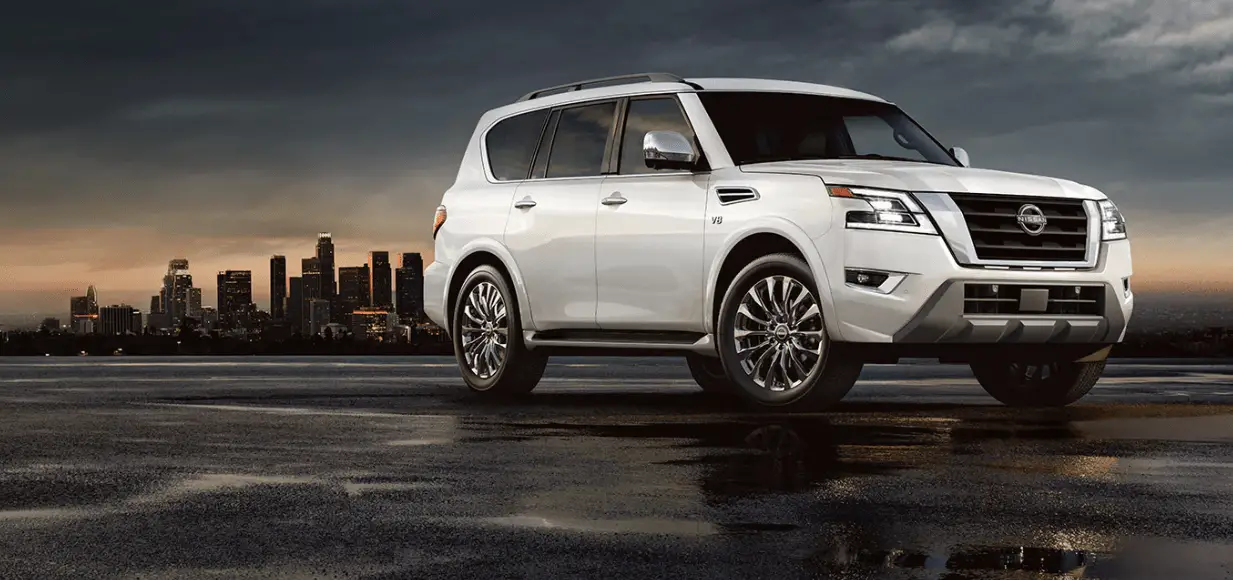Nissan ARMADA 2022 “Automatic Emergency Braking and Intelligent Forward Collision Warning”
The 2022 Nissan Armada puts safety first with its Automatic Braking and Intelligent Forward Collision Warning systems. These systems change the way you drive by adding a new level of protection. A complex network of sensors, such as radar and cameras, in these cutting-edge technologies constantly scan the road ahead, giving drivers extra trust by giving them an extra set of eyes. The Automatic Braking system is a powerful safety feature that can recognise impending crashes and quickly apply the brakes if the driver doesn’t react in time, thereby greatly lowering the risk of accidents. In addition, the Intelligent Forward Collision Warning system works as a watchdog, warning the driver of possible dangers in their path, such as a slowing vehicle or an unexpected obstacle, giving them plenty of time to avoid them. All of these features show how much Nissan cares about safety. The 2022 Nissan Armada will bring a new era of peace of mind and avoiding accidents.
2023 Nissan Armada Specs, Price, Features and Mileage (Brochure)
AUTOMATIC EMERGENCY BRAKING (AEB) WITH PEDESTRIAN DETECTION SYSTEM
WARNING
Failure to follow the warnings and instructions for proper use of the AEB with pedestrian detection system could result in serious injury or death.
- The AEB with pedestrian detection system is a supplemental aid to the driver. It is not a replacement for the driver’s attention to traffic conditions or responsibility to drive safely. It cannot prevent accidents due to carelessness or dangerous driving techniques.
- The AEB with pedestrian detection system does not function in all driving, traffic, weather and road conditions.
The AEB with pedestrian detection system can assist the driver when there is a risk of a forward collision with
- a vehicle ahead in the travelling lane
- a pedestrian ahead in the travelling lane

The AEB with pedestrian detection system uses a radar sensor located on the front of the vehicle to measure the distance to the vehicle ahead in the same lane.
For pedestrians, the AEB system uses a camera installed behind the windshield in addition to the radar sensor.

- AEB emergency warning indicator
- Vehicle ahead detection indicator (on the vehicle information display)
- AEB system warning light (on the meter panel)
- Steering-wheel-mounted controls (left side)
AEB WITH PEDESTRIAN DETECTION SYSTEM OPERATION
The AEB with pedestrian detection system will function when your vehicle is driven at speeds above approximately 3 MPH (5 km/h).
For the pedestrian detection function, the AEB with pedestrian detection system operates at speeds between 6 – 37 MPH (10 – 60 km/h).
If a risk of a forward collision is detected, the AEB with pedestrian detection system will first provide the warning to the driver by flashing the vehicle ahead detection indicator (yellow) in the vehicle information display and providing an audible alert. In addition, the system applies partial braking.
If the driver applies the brakes quickly and forcefully after the warning, and the AEB with pedestrian detection system detects that there is still the possibility of a forward collision, the system will automatically increase the braking force.
If the driver does not take action, the AEB with the pedestrian detection system issues the second visual (flashing) (red) and audible warning. Then the system applies partial braking.
If the risk of a collision becomes imminent, the AEB with pedestrian detection system applies harder braking automatically.
While the AEB with pedestrian detection system is operating, you may hear the sound of brake operation. This is normal and indicates that the AEB with pedestrian detection system is operating properly.
NOTE:
The vehicle’s stop lights come on when braking is performed by the AEB with a pedestrian detection system.
Depending on vehicle speed and distance to the vehicle or pedestrian ahead, as well as driving and roadway conditions, the system may help the driver avoid a forward collision or may help mitigate the consequences of a collision should one be unavoidable.
If the driver is handling the steering wheel, accelerating or braking, the AEB with pedestrian detection system will function later or will not function.
The automatic braking will cease under the following conditions:
- When the steering wheel is turned as far as necessary to avoid a collision.
- When the accelerator pedal is de- pressed.
- When there is no longer a vehicle, pedestrians are detected ahead.
If the AEB with pedestrian detection system has stopped the vehicle, the vehicle will remain at a standstill for approximately 2 seconds before the brakes are released.
When the brake pedal is depressed while the brake is applied by the system, you may feel the pedal effort is changed and may hear a sound and vibration noise. This is normal and does not indicate a malfunction. In addition, the braking force can be increased by adding the pedal effort.
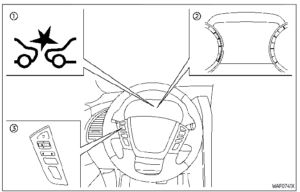
- AEB system warning light (on the meter panel)
- Vehicle information display
- Steering-wheel-mounted controls (left side)
TURNING THE AEB WITH PEDES- TRIAN DETECTION SYSTEM ON/OFF
Perform the following steps to turn the AEB with the pedestrian detection system on or off.
- Push the button until “Settings” appears in the vehicle information display and then push the OK. Use the to select “Driver Assistance.” Then push the OK.
- Select “Emergency Brake” and push the OK.
- Select “Front” and use the OK to turn the system on or off.
When the AEB with pedestrian detection system is turned off, the AEB system warning light illuminates.
NOTE:
- The AEB with pedestrian detection system will be automatically turned ON when the engine is restarted.
- The Intelligent Forward Collision Warning (I-FCW) system is integrated into the AEB system. There is not separate selection for the I-FCW system. When the I-FCW system is also turned off.
AEB WITH PEDESTRIAN DETECTION SYSTEM LIMITATIONS
WARNING
Listed below are the system limitations for the AEB with the pedestrian detection system. Failure to operate the vehicle in accordance with these system limitations could result in serious injury or death.
- The AEB with a pedestrian detection system cannot detect all vehicles or pedestrians under all conditions.
- The AEB with pedestrian detection system does not detect the following:
- Small pedestrians (for example, children), in a sitting position, operating toys/skateboards, on scooters or in wheelchairs, or not in an upright standing or walking position.
- Animals of any size.
- Obstacles (for example, cargo or debris) on the roadway or roadside.
- Oncoming or crossing vehicles.
Vehicles where the tires are difficult to see or the shape of the rear of the vehicle is unclear or obstructed. - Parked vehicles.
- The AEB with pedestrian detection system has some performance limitations.
- If a stationary vehicle is in the vehicle’s path, the system will not function when the vehicle approaches the stationary vehicle at speeds over approximately 50 MPH (80 km/h).
- Pedestrian detection will not function when the vehicle is driven at speeds over approximately 37 MPH (60 km/h) or below approximately 6 MPH (10 km/h).
- For pedestrians, the AEB with a pedestrian detection system will not issue the first warning.
- The AEB with pedestrian detection system may not function properly or detect a vehicle or pedestrian ahead in the following conditions:
- In poor visibility conditions (such as rain, snow, fog, dust storms, sand storms, smoke, and road spray from other vehicles).
- If dirt, ice, snow, fog or other material is covering the radar sensor area or camera area of the windshield.
- If strong light (for example, sunlight or high beams) enters the front camera or a sudden change in brightness occurs (for example, entering a tunnel or driving in lightning).
- In dark or dimly lit conditions, such as at night or in tunnels, including cases where your vehicle’s headlights are off or dim, or the tail lights of the vehicle ahead are off.
- When the direction of the camera is misaligned.
- When driving on a steep downhill slope, on roads with sharp curves, and/or bumpy or dirt roads.
- If there is interference by other radar sources.
- When your vehicle’s position or movement is changed quickly or significantly (for example, lane change, turning vehicle, abrupt steering, sudden acceleration or deceleration).
- When your vehicle or the vehicle or pedestrian ahead moves quickly or significantly such that the system cannot detect and react in time (for example, pedestrian moving quickly toward the vehicle at close range, vehicle cutting in, changing lanes, making a turn, steering abruptly, sudden acceleration or deceleration).
- When the vehicle or pedestrian is offset from the vehicle’s forward path.
- If the speed difference between the two vehicles is small.
- The pedestrian’s profile is partially obscured or unidentifiable; for example, due to transporting luggage, pushing a stroller, wearing bulky or very loose-fitting clothing or accessories, or being in a unique posture (such as raising hands).
- There is poor contrast of a person to the background, such as having clothing color or pattern which is similar to the background.
- For approximately 15 seconds after starting the engine
- If the vehicle ahead has a unique or unusual shape, extremely low or high clearance heights, or unusual cargo loading or is narrow (for example, a motorcycle).
- When the vehicle or pedestrian is located near a traffic sign, a reflective area (for example, water on road), or is in a shadow.
- When multiple pedestrians are grouped together.
- When the view of the pedestrian is obscured by a vehicle or other object.
- While towing a trailer or other vehicle.
- The system performance may be degraded in the following conditions:
- The vehicle is driven on a slippery road.
- The vehicle is driven on a slope.
- Excessively heavy baggage is loaded in the rear seat or the cargo area of your vehicle.
- The system is designed to automatically check the sensor (radar and camera)’s functionality, within certain limitations. The system may not detect some forms of obstruction of the sensor area such as ice, snow or stickers, for example. In these cases, the system may not be able to warn the driver properly. Be sure that you check, clean, and clear sensor areas regularly.
- In some road and traffic conditions, the AEB with a pedestrian detection system may unexpectedly apply partial braking. When acceleration is necessary, depress the accelerator pedal to override the system.
- The AEB with pedestrian detection system may operate when a pattern, object, shadow or lights are detected that are similar to the outline of vehicles or pedestrians, or if they are the same size and position as a vehicle or motorcycle’s tail lights.
- The system may keep operating when the vehicle ahead is turning right or left.
- The system may operate when your vehicle is approaching and passing a vehicle ahead.
- Depending on the road shape (curved road, entrance, and exit of the curve, winding road, lane regulation, under construction, etc.), the system may operate temporarily for the oncoming vehicle in front of your vehicle.

WARNING
Listed below are the system limitations for the AEB with the pedestrian detection system. Failure to operate the vehicle in accordance with these system limitations could result in serious injury or death.
- The AEB with pedestrian detection system may react to:
- objects on the roadside (traffic sign, guardrail, pedestrian, vehicle, etc.)
- pedestrians when driving on narrow alleys, etc.
- pedestrians who temporarily protrude into or approach the driving lane to avoid the obstacles on the road shoulder
- objects above the road (Cowbridge, traffic sign, etc.)
- objects on the road surface (railroad track, grate, steel plate, etc.)
- objects in the parking garage (beam, pillar, etc.)
- pedestrians approaching the traveling lane
- vehicles, pedestrians or objects in adjacent lanes or close to the vehicle
- oncoming pedestrians
- objects on the road (such as trees)
- Braking distances increase on slippery surfaces.
- Excessive noise will interfere with the warning chime sound, and the chime may not be heard.

When driving on some roads, such as winding, hilly, curved, narrow roads, or roads that are under construction or on a slope, the sensor may detect vehicles in a different lane, or may temporarily not detect a vehicle traveling ahead. This may cause the system to work inappropriately.
The detection of vehicles may also be affected by vehicle operation (steering manoeuvre or travelling position in the lane, etc.) or vehicle condition. If this occurs, the system may warn you by blinking the system indicator and sounding the chime unexpectedly. You will have to manually control the proper distance away from the vehicle travelling ahead.
SYSTEM TEMPORARILY UNAVAILABLE Condition A
In the following conditions, the AEB system warning light (orange) will blink and the system will be turned off automatically.
- The camera area of the windshield is misted or frozen.
- strong light is shining from the front. . The cabin temperature is over approximately 104°F (40°C) in direct sunlight.
- The camera area of the windshield glass is continuously covered with dirt, etc.
Action to take:
When the above conditions no longer exist, the AEB with pedestrian detection system will resume automatically.
NOTE:
When the inside of the windshield on the camera area is misted or frozen, it will take a period to remove it after air conditioner turns on. If dirt appears on this area, it is recommended you visit a NISSAN dealer.
Condition B
When the radar sensor picks up interference from another radar source, making it impossible to detect a vehicle ahead, the AEB system is automatically turned off. The AEB system warning light (orange) will illuminate.
Action to take:
When the above conditions no longer exist, the AEB system will resume automatically.
Condition C
Under the following conditions, making it impossible to detect a vehicle ahead, the AEB with pedestrian detection system is automatically turned off.
The AEB system warning light (orange) will illuminate and the “Forward Driving Aids temporarily disabled Front Sensor blocked See Owner’s Manual” warning message will appear in the vehicle information display.
- When the sensor area of the front the bumper is covered with dirt or is obstructed
Action to take:
If the AEB system warning light (orange) comes on, stop the vehicle in a safe place, place the shift lever in the P (Park) position and turn the engine off. Clean the radar cover below the front bumper with a soft cloth, and restart the engine. If the AEB system warning light continues to illuminate, have the AEB with pedestrian detection system checked. It is recommended you visit a NISSAN dealer for this service. - When driving on roads with limited road structures or buildings (for example, long bridges, deserts, snow fields, driving next to long walls)
Action to take:
When the above conditions no longer exist, the AEB with pedestrian detection system will resume automatically.
Condition D
When the accelerator pedal actuator detects that the internal motor temperature is high, the AEB with pedestrian detection system is automatically turned off. The AEB system warning light (orange) will illuminate.
Action to take:
When the above conditions no longer exist, the AEB with pedestrian detection system will resume automatically.
Condition E
When the VDC system is OFF, the AEB brake will not operate. In this case, only visible and audible warning operates. The AEB system warning light (orange) will illuminate.
Action to take:
When the VDC system is ON, the AEB with the pedestrian detection system will resume automatically.
SYSTEM MALFUNCTION
If the AEB with pedestrian detection system malfunctions, it will be turned off automatically, a chime will sound, the AEB system warning light will (orange) will illuminate and the “Malfunction” warning message will appear in the vehicle information display.
Action to take:
If the warning light (orange) comes on, stop the vehicle in a safe location. Turn the engine off and restart the engine. If the warning light continues to illuminate, have the AEB with the pedestrian detection system checked. It is recommended that you visit a NISSAN dealer for this service.
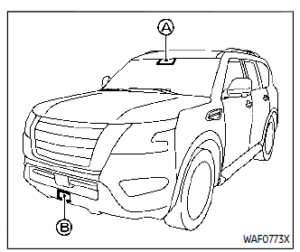
SYSTEM MAINTENANCE
The radar sensor is located on the front of the vehicle. The camera is located on the upper side of the windshield.
To keep the AEB with the pedestrian detection system operating properly, be sure to observe the following:
- Always keep the sensor area on the front of the vehicle and windshield clean.
- Do not strike or damage the areas around the sensors (ex. bumper, windshield).
- Do not cover or attach stickers or similar objects on the front of the vehicle near the sensor area. This could cause failure or malfunction.
- Do not attach metallic objects near the radar sensor area (brush guard, etc.). This could cause failure or malfunction.
- Do not place reflective materials, such as white paper or a mirror, on the instrument panel. The reflection of sunlight may adversely affect the camera unit’s detection capability.
- Do not alter, remove or paint the front of the vehicle near the sensor area. Before customizing or restoring the sensor area, it is recommended that you visit a NISSAN dealer.
Radiofrequency statement
Model: ARS4–A
IC: 4135A-ARS4A
FCC ID: OAYARS4A
This device complies with Part 15 of the FCC Rules and with Industry Canada license-exempt RSS standard(s). Operation is subject to the following two conditions:
- This device may not cause harmful interference, and
- This device must accept any interference received, including interference that may cause undesired operation.
2023 Nissan Armada Specs, Price, Features and Mileage (Brochure)
INTELLIGENT FORWARD COLLISION WARNING (I-FCW)
WARNING
Failure to follow the warnings and instructions for proper use of the I-FCW system could result in serious injury or death.
- The I-FCW system helps warn the driver before a collision but will not avoid a collision. It is the driver’s responsibility to stay alert, drive safely and be in control of the vehicle at all times.
- The I-FCW system can help alert the driver when there is a sudden braking of a second vehicle traveling in front of the vehicle ahead in the same lane.

The I-FCW system uses a radar sensor located on the front of the vehicle to measure the distance to a second vehicle ahead in the same lane.

- Vehicle ahead detection indicator (on the vehicle information display)
- Automatic Emergency Braking (AEB) system warning light (on the meter panel)
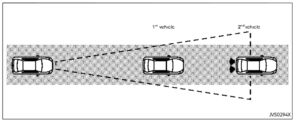
I-FCW SYSTEM OPERATION
The I-FCW system operates at speeds above approximately 3 MPH (5 km/h).
If there is a potential risk of a forward collision, the I-FCW system will warn the driver by blinking the vehicle ahead detection indicator, and sounding an audible alert
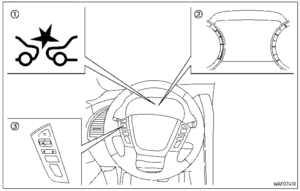
- AEB system warning light (on the meter panel)
- Vehicle information display
- Steering-wheel-mounted controls (left side)
TURNING THE I-FCW SYSTEM ON/ OFF
Perform the following steps to turn the I-FCW system on or off.
- Push the button until “Settings” appears in the vehicle information display and then push the OK. Use the to select “Driver Assistance.” Then push the OK.
- Select “Emergency Brake” and push the OK.
- Select “Front” and use the OK to turn the system on or off.
When the I-FCW system is turned off, the AEB system warning light (orange) illuminates.
NOTE:
- The I-FCW system will be automatically turned on when the engine is restarted.
- The I-FCW system is integrated into the AEB system. There is not a separate selection for the I-FCW system. When the AEB system is turned off, the I-FCW system is also turned off.
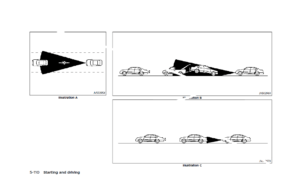
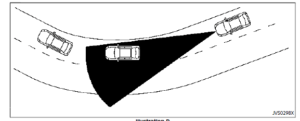
I-FCW SYSTEM LIMITATIONS
WARNING
Listed below are the system limitations for the I-FCW system. Failure to operate the vehicle in accordance with these system limitations could result in serious injury or death.
- The I-FCW system cannot detect all vehicles under all conditions.
- The radar sensor does not detect the following objects:
- Pedestrians, animals or obstacles in the roadway
- Oncoming vehicles
- Crossing vehicles
- (Illustration A) The I-FCW system does not function when a vehicle ahead is a narrow vehicle, such as a motorcycle.
- The radar sensor may not detect a vehicle ahead in the following conditions:
- Snow or heavy rain
- Dirt, ice, snow or other material covering the radar sensor
- Interference by other radar insources
- Snow or road spray from traveling vehicles.
- Driving in a tunnel
- Towing a trailer
- (Illustration B) When the vehicle ahead is being towed.
- (Illustration C) When the distance to the vehicle ahead is too close, the beam of the radar sensor is obstructed.
- (Illustration D) When driving on a steep downhill slope or roads with sharp curves.
- The system is designed to automatically check the sensor’s functionality, within certain limitations. The system may not detect some forms of obstruction of the sensor area such as ice, snow, stickers, for example. In these cases, the system may not be able to warn the driver properly. Be sure that you check, clean and clear the sensor area regularly.
- Excessive noise will interfere with the warning chime sound, and the chime may not be heard.
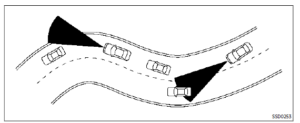
When driving on some roads, such as winding, hilly, curved, narrow roads, or roads that are under construction, the radar sensor may detect vehicles in a different lane, or may temporarily not detect a vehicle traveling ahead. This may cause the I-FCW system to work inappropriately.
The detection of vehicles may also be affected by vehicle operation (steering maneuver or traveling position in the lane, etc.) or vehicle condition. If this occurs, the system may warn you by blinking the vehicle ahead detection indicator and sounding the chime unexpectedly. You will have to manually control the proper distance away from the vehicle traveling ahead.
SYSTEM TEMPORARILY UNAVAILABLE
Condition A
When the radar sensor picks up interference from another radar source, making it impossible to detect a vehicle ahead, the I-FCW system is automatically turned off. The AEB system warning light (orange) will illuminate.
Action to take:
When the above conditions no longer exist, the I-FCW system will resume automatically.
Condition B
Under the following conditions, making it impossible to detect a vehicle ahead, the I-FCW system is automatically turned off.
The AEB system warning light (orange) will illuminate and the “Forward Driving Aids temporarily disabled Front Sensor blocked See Owner’s Manual” warning message will appear in the vehicle information display.
- When the sensor area of the front of the vehicle is covered with dirt or is obstructed
Action to take:
If the warning light (orange) flashes, stop the vehicle in a safe place, push the park button to engage the P (Park) position, and turn the engine off. Clean the radar cover on the front of the vehicle with a soft cloth, and restart the engine. If the warning light continues to illuminate, have the I-FCW system checked. It is recommended you visit a NISSAN dealer for this service. - When driving on roads with limited road structures or buildings (for example, long bridges, deserts, snow fields, driving next to long walls)
Action to take:
When the above conditions no longer exist, the I-FCW system will resume automatically.
SYSTEM MALFUNCTION
If the I-FCW system malfunctions, it will be turned off automatically, a chime will sound, the AEB system warning light (orange) will illuminate and the “Malfunction” warning message will appear in the vehicle information display.
Action to take:
If the warning light (orange) illuminates, stop the vehicle in a safe location. Turn the engine off and restart the engine. If the warning light continues to illuminate, have the I-FCW system checked. It is recommended you visit a NISSAN dealer for this service.

SYSTEM MAINTENANCE
The radar sensor is located on the front of the vehicle.
To keep the system operating properly, be sure to observe the following:
- Always keep the sensor area on the front of the vehicle clean.
- Do not strike or damage the areas around the sensor.
- Do not cover or attach stickers or similar objects on the front bumper near the sensor area. This could cause failure or malfunction.
- Do not attach metallic objects near the sensor area (brush guard, etc.). This could cause failure or malfunction.
- Do not alter, remove or paint the front bumper. It is recommended you contact a NISSAN dealer before customizing or restoring the front bumper.
Radiofrequency statement
Model: ARS4–A
IC: 4135A-ARS4A
FCC ID: OAYARS4A
This device complies with Part 15 of the FCC Rules and with Industry Canada license-exempt RSS standard(s). Operation is subject to the following two conditions:
- This device may not cause harmful interference, and
- This device must accept any interference received, including interference that may cause undesired operation.
FAQ
The automatic braking system in the 2022 Nissan Armada is a safety feature that can automatically apply the brakes if a potential collision is detected.
It uses sensors, such as radar and cameras, to monitor the road ahead. If it senses an imminent collision and the driver doesn’t react in time, it can apply the brakes to mitigate or prevent the impact.
Intelligent Forward Collision Warning is a system that warns the driver if it detects a potential collision with the vehicle in front.
It uses sensors to monitor the distance and relative speed of the vehicle ahead. If it calculates that a collision is likely, it provides a warning to the driver.
Most modern vehicles, including the 2022 Nissan Armada, allow you to disable certain driver assistance features, but it’s generally recommended to keep them active for safety.
Some vehicles allow you to adjust the sensitivity of the automatic braking system, but the extent of adjustment may vary by model.
The capabilities of the automatic braking system may vary, but it typically works at a range of speeds.
Depending on the vehicle’s specifications, Intelligent Forward Collision Warning may be capable of detecting both vehicles and pedestrians.
Yes, most systems provide both visual and audible warnings to alert the driver of a potential collision.
Some vehicles allow you to adjust the warning settings, including the timing and sensitivity of the warnings.
“Intelligent” Forward Collision Warning typically implies a more advanced system that may include additional features or capabilities.
Some vehicles come equipped with a reverse automatic braking system, but you should check the specific features of the 2022 Nissan Armada to confirm if it has this capability.
The availability of these features may vary by trim level, so it’s a good idea to check the specifications of the specific trim you’re interested in.
The reliability of these features can depend on various factors, including maintenance and environmental conditions. However, Nissan typically designs its safety systems to be reliable.
Nissan vehicles often come equipped with a suite of safety features, so you should explore the full list of safety technologies to see what complements these features for enhanced safety.
Useful Link
View Full User Guide: Nissan ARMADA 2022 User Guide
Download Manuals: https://www.nissanusa.com/owners/ownership/manuals-guides.html
2023 Nissan Armada Specs, Price, Features and Mileage (Brochure)

